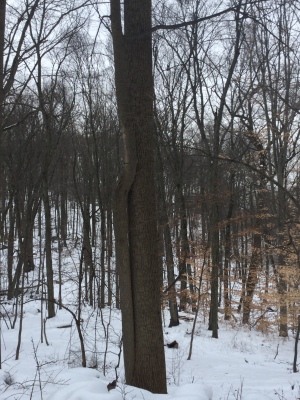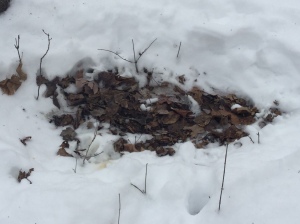A snowstorm on Thursday brought us twelve inches of snow. I knew I would be in for a tougher hike this month. The temperature wasn’t that cold – just above freezing, no windchill factor. The sky decided to become overcast at the last minute. Unlike the February two years ago, I now had proper footwear and no excuse to skip the hike.
Driving in, I flushed at least three dozen Dark-eyed Juncos foraging for grit on the road. I caught a blue flash from a bright male Eastern Bluebird zooming over my car. When I parked and got out to gather my gear, I heard a number of birds unceasingly sing or call: White-breasted Nuthatch, Blue Jay, Tufted Titmouse, Black-capped Chickadee, and Carolina Wren. Though that doesn’t seem like many species, it’s certainly a huge difference compared to the quiet that had been reigning since fall migration’s end. Winter birds begin singing to claim territory in February. By this time, the amount of daylight has substantially increased since the solstice. The birds have taken their cue. Earlier this week, in my neighborhood, I heard a House Finch and a Northern Cardinal sing for the first time this year.
Hike leader Mike arrived shortly after I did. There were no other cars parked on the un-plowed lot. The snow cover wasn’t unoutched. Visitors had already stopped by sometime after the storm. As we waited for additional hikers, a Red-tailed Hawk flew over our heads. A flock of seven rowdy Blue Jays landed in a tree above us. Seconds later, they flew away. Gerry Weinstein would be the only other person to join us this month. We three set out.

Trail’s beginning. © S.G. Hansen
We rested a bit at the trail map fork (which I call the warbler corner during the warmer months). The amount of trail from the parking lot to this point wouldn’t be considered a hike, but because of the snow, my heart beat as if I’d just finished jogging a mile. I was sweating. I took off my gloves. People and dogs had already stomped on the snow for us, but I still felt like I hiked on sand.These people even blazed a trail for deer, who left hoof-prints over boot-prints.
Not as much activity here. I continued to hear the same birds from before, plus a House Finch sweetly twittering somewhere east, out of our view. We barely saw a Red-bellied Woodpecker against the backlighting. The parking lot and the map area were apparently the only hotspots in the sanctuary that morning. It wasn’t until the very end, when we nearly completed our loop, that we came across a lot of activity again. At the pond, now frozen, the winter trio (chickadee, titmouse, nuthatch) made some noise and we bothered a male Northern Cardinal, who chipped at us in annoyance by the side of the trail.

Itty bitty birdie tracks – likely belonging to Dark-eyed Juncos – around Black Birch seed hulls. © S.G. Hansen
Other than the occasional nuthatch, jay, and crow, we trudged through silence. At least, I was trudging. Somehow I became the leader of the single-file line, followed by Gerry and then Mike. I was glad for the fact that the snow was still fluffy and not at all icy. But I’m a short person with short legs. Hiking through six inches of snow is a doozy for me. I may regularly visit the gym, but I only hike once a month, not counting any walking I do when I birdwatch. “You’ve slowed down,” Mike commented as we trekked uphill to the powerlines. I don’t remember what I said in response, but I was looking forward to soon completing the hardest part of the hike.

A Tulip Tree (its trunk is on the right) has absorbed another tree into itself. © S.G. Hansen
When we neared the top of the hill, we heard a loud, rapid drumming. Based on the intensity, I guessed that the drumming belonged to one of the resident Pileated Woodpeckers. I tried looking for it with my binoculars. The bird drummed a couple more times. I couldn’t find it – too far away from us, hard to pinpoint its location. I was sure we were hearing Pileated. It was very similar to the drumming I heard by the pond last month, when I did eventually find the bird responsible for the drumming.
We decided not to walk the powerlines earlier, but Mike and Gerry wanted to at least venture out for a moment. Mike blazed through the virgin snow as if there weren’t any snow. (He may tell you he’s out of shape, but it’s up to you if you believe him or not.) I didn’t think there would be (m)any birds, but I followed behind somewhat reluctantly. We were treated to a lovely view of snow-coated mountains to the north – namely, Bear Mountain and Anthony’s Nose. A steady, thick steam cloud rose from Indian Point. Winter silence accompanied the scenery.
Mike, puzzled by the lack of bird presence, pointed to certain plants. The birds should be eating this, the birds should be eating that, and that, and that. We’d seen a good amount of berries and seeds for the birds to eat as we hiked, but the foods remained untouched. “Why don’t you pish?” Mike offered.
I don’t remember what I replied, maybe I simply mumbled and trailed off. With this much snow covering the ground – which could also be called “the great flat food-provider” – I imagined the birds wouldn’t want to waste their energy being bothered over nothing. I didn’t pish. I heard was some cawing from crows I couldn’t see and a chickadee’s tinny “feebee.” All I saw were a few juncos by the sanctuary’s edge and a jay or two flying about. While I distractedly looked around, Gerry spotted a woodpecker racing from one side of the field to the other. I was able to get on it with my binoculars mid-flight and noticed a particular mustache. Northern Flicker! Gerry had never seen a flicker before. Unfortunately, he couldn’t get a very good look at it when it perched. We bemoaned the awful lighting.

Deer bedding. © S.G. Hansen
We didn’t hike our usual route (going the powerlines, then onto the green and white trails, and finally back onto the yellow). Instead, we continued on the blue trail to the yellow trail, which loops the pond. There were no birds to hear or see during our descent from the powerlines, so Gerry, Mike and I began concentrating on animal tracks. Gerry owned a pamphlet on tracks and scat, but he left it in his cottage. Still, guessing which tracks were which by memory alone was part of the entertainment, especially when it came to discerning the difference between dog and coyote. (Coyote’s look more oval-shaped. The footpads are triangular, and the claws aren’t as pronounced as they are in dog tracks. Sometimes, a dragging line trails the prints, indicating a tail, which would definitely belong to a dog.) Of course, we saw dog tracks on every inch of trail we hiked. We also found a couple coyote tracks, some more deer, and one belonging to an Eastern Cottontail rabbit. Wherever we came across fallen birch seeds, we found small bird tracks.
As soon as we approached trail’s end, we were met with a burst of activity. A large flock of juncos foraged on the hillside (presumably the same flock I flushed from before). I suddenly noticed wings fluttering against a tree trunk near us. I assumed “nuthatch” right away, but then I saw familiar flurry of moth mottled brown: Brown Creeper!! I’m always happy to see a creeper, as it is my ultimate favorite bird and I don’t see them frequently. I miss them during spring and summer. They’re winter birds for Westtchester. Watching a creeper – whether I’m birdwatching or just out-and-about – makes my day, no matter how well my day is going. This one was the fourth creeper I had seen so far this year. Looking back at my past Brinton Brook lists, I apparently noted the last sighting in November 2014. A bit sad…
I maintained my focus on the creeper for as long as it was in my sight. Its small, jerky movements will never lose charm, and neither will the way it flutters from tree to tree. I did stray my binoculars to ID a Hairy Woodpecker. Another species for the list. Always welcomed after so many Downy’s. Mike and Gerry indulged me and waited patiently. Gerry had never seen a creeper before (that made two new species for him this morning) and watched it with interest. He wasn’t able to keep up with it as I did, so he turned his attention to the juncos. When I finally lost the creeper, we walked ahead. The juncos had disappeared. From at that point to the parking lot, I heard the Blue Jays continue their ruckus, the lone House Finch from before sing away, an American Robin “yeep!!” a few times, and another Carolina Wren sing about tea kettles (or cheeseburgers, if you will). I was positive I heard the question mark note of an American Goldfinch.
We completed the hike in 1 hour and 45 minutes. Less than average, even with periodic rests, but still a workout because of the snow. I counted up to 19 species. You can view the eBird list here: http://ebird.org/ebird/view/checklist/S34344128